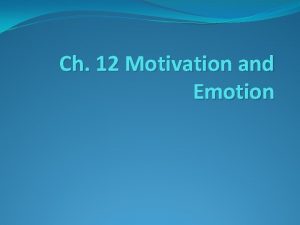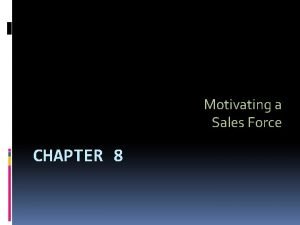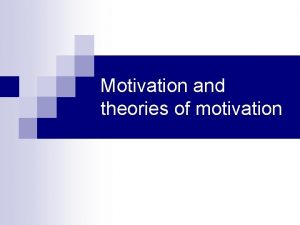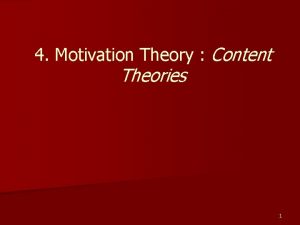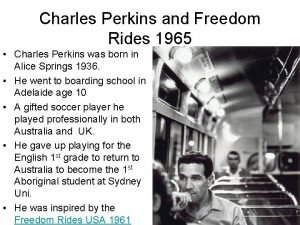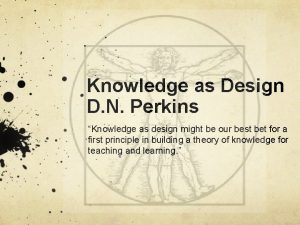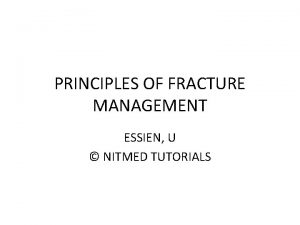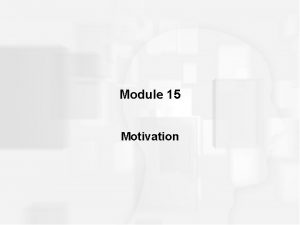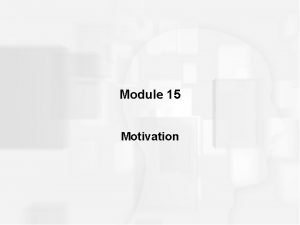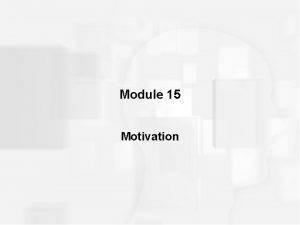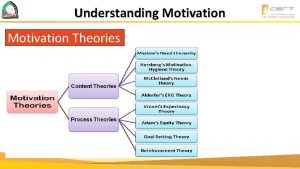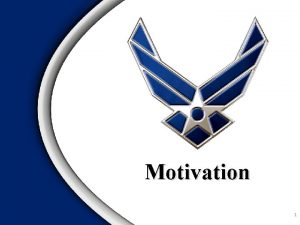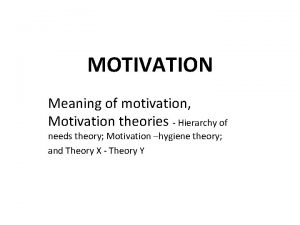Worker Motivation Scott Perkins Outline Motivation Theories of

















- Slides: 17

Worker Motivation Scott Perkins

Outline • Motivation • Theories of Motivation • Measurements – MTQ – MMI – WMI • Interventions

Motivation • The desire or reason responsible for behavior. – Determines intensity, direction, and quality of behavior. • Based on desire/need, incentive/reward, and self-expectations and expectations from others. • Extrinsic vs. Intrinsic Motivation

Work and Motivation • Performance – Performance = (Motivation x Ability) – Situational Constraints • Work/Home Interaction – Both satisfaction at work and home influence motivation.

Work and Motivation • Attitudes – Feelings/beliefs directed toward tasks, ideas, individuals, etc. • Personality – Judge & Ilies (2002) – Strong relationship between Big 5 personality measures and motivation.

Theories of Motivation • Field Theory/Group Dynamics – Various forces interacting to result in the outcome behavior. • Reinforcement Theory – Stimulus, Response, & Reward (contingent, intermittent, or continuous).

Theories of Motivation • Maslow’s Hierarchy of Needs – Basic set of needs driving behavior.

Theories of Motivation • Dissonance Theory – Dissonant cognitions = tension. – Motivated to avoid dissonance. • Path-Goal Theory – Having a goal in mind and believing in the path to the goal will result in the necessary “path” behavior to achieve that goal.

Theories of Motivation • V. I. E. – Valence: weighing importance of rewards/outcomes. – Instrumentality: performance that leads to the outcomes. – Expectancy: effort leads to performance.

Theories of Motivation • Equity Theory – Individuals compare themselves with peers in terms of an input/outcome ratio. • Individuals aim to correct discrepancies between self and peers.

Theories of Motivation • Goal-Setting – Setting specific, difficult, attainable goals. – Objective vs. Subjective

Measurements • Motivational Trait Questionnaire (MTQ) – 48 items measuring six dimensions of general motivation. • Psychometrics – Test-retest. 80 – Strong construct validity – Chronbach’s alpha >. 85 for subscales • . 83 Overall

Measures • Meta-Motivation Inventory (MMI) – Used to assess personal and managerial development by comparing how individuals stand in relation to the normal population. Feedback on personal/managerial styles. – Major Scales: Determinism, Motivation to Achieve, Need to Control Others, & Concern for People.

Measures • MMI - Psychometrics – Test-retest: Major Scales range. 84 -. 87. – Strong concurrent validity. – Convergent validity correlated with 12 other established scales. – Distinguishes between levels of management, female managers vs. female non-managers, and top vs. bottom sales people.

Measurements • Work Motivation Inventory (WMI) – Evaluates importance placed on: • Accomplishment, Recognition, Power, & Affiliation – Additional bias scale measuring - tendency to present oneself in a positive light. – 65 likert-type items. – Psychometrics • Internal consistencies (main four): . 81 -. 84 • Test-retest: . 59 -. 80. • Construct validity acceptable when cross-validated with MBTI scores.

Interventions to Increase Motivation • Contingent Rewards – Identifying target behaviors/goals and outlining rewards contingent upon target behaviors. • Job Enrichment – Jobs that satisfy a higher need (Maslow) will motivate individuals. – Skill variety, task identity, significance, autonomy, feedback.

Interventions to Increase Motivation • Pro. MES – Productivity Measurement and Enhancement System – Maximize motivation to increase productivity. – Productivity – properly allocating resources to obtain goals. – System steps – Form a design team, identify objectives, identify indicators, define contingencies, design feedback system, give/respond to feedback, monitor.
 How to become a family support worker in ireland
How to become a family support worker in ireland Incentive theory
Incentive theory Sales force motivation theories
Sales force motivation theories Components of motivation
Components of motivation Equity theory of motivation
Equity theory of motivation Motivation theories ib business
Motivation theories ib business Arousal theory of motivation example
Arousal theory of motivation example Tujuan pengajaran
Tujuan pengajaran Motivation to learn an overview of contemporary theories
Motivation to learn an overview of contemporary theories Content theories of motivation
Content theories of motivation Motivation theories
Motivation theories Charles perkins and the freedom rides
Charles perkins and the freedom rides Perkins formula fracture healing
Perkins formula fracture healing Knowledge as design
Knowledge as design Chris perkins physio
Chris perkins physio Perkins timetable of fracture healing
Perkins timetable of fracture healing Cte funding texas
Cte funding texas Rachel perkins clinical psychologist
Rachel perkins clinical psychologist

